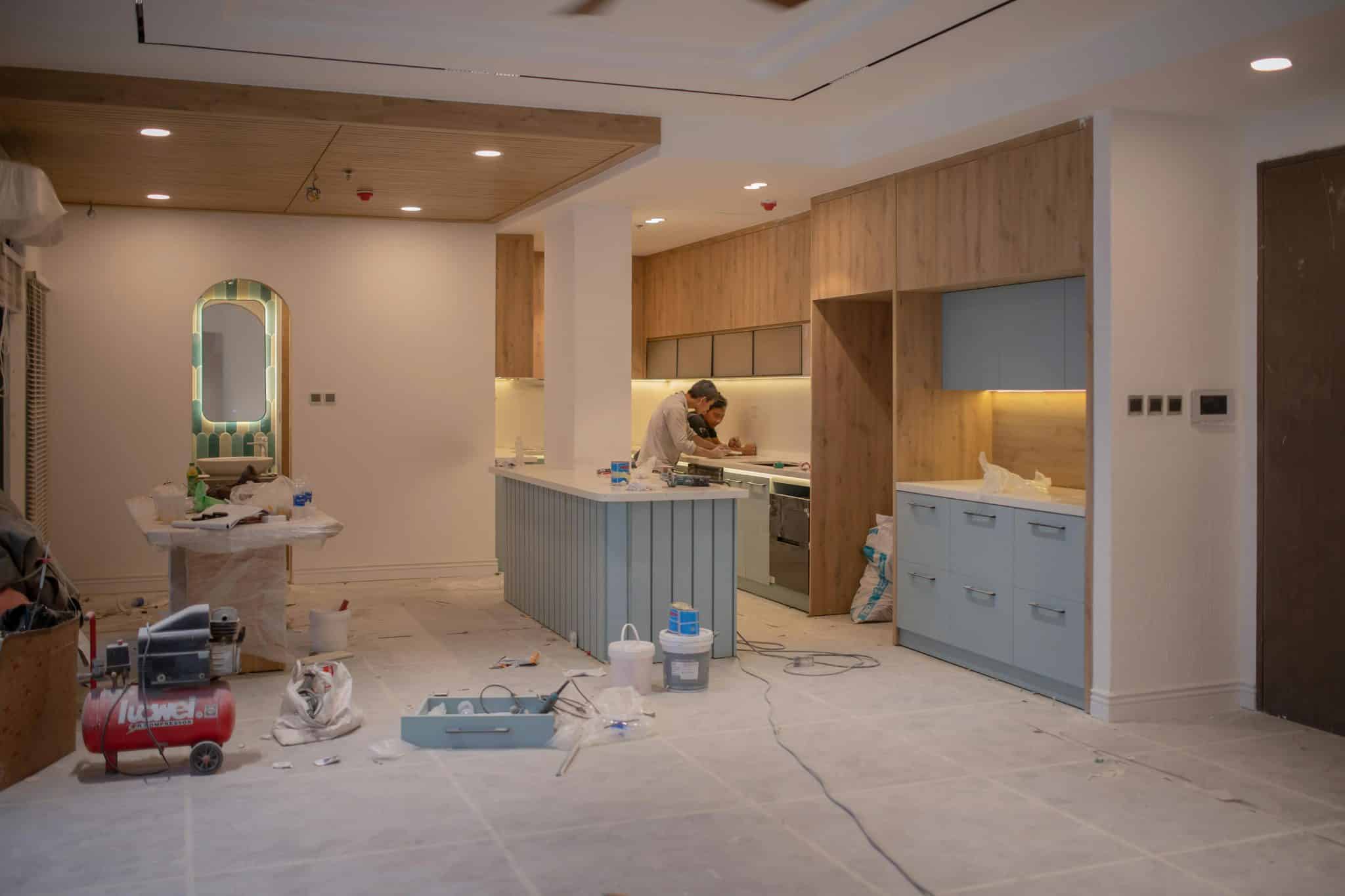Does your driveway have uneven sections that make you worry about tripping?
You’re not alone. Sunken concrete affects millions of homeowners every year, creating safety hazards and reducing property values.
The good news is that modern repair methods can fix most settling issues in just a few hours — without major disruption. Modern repair methods can fix most settling issues in just a few hours, often costing less than complete replacement.
This article covers everything you need to know about sunken concrete repair, from identifying the root causes to choosing the right repair method for your situation.
You’ll learn about cost-effective solutions, prevention strategies, and when to call professionals versus handling repairs yourself. Keep reading to find the perfect solution for your sunken concrete problems.
Recognizing Sunken Concrete Before It Gets Worse
Sunken concrete is a common issue that affects driveways, sidewalks, patios, and garage floors. When concrete slabs settle below their original level, they create uneven surfaces that pose safety risks and reduce property value.
Key signs of sunken concrete include:
- Visible gaps between concrete sections
- Uneven surfaces that cause tripping hazards
- Water pooling in low areas
- Cracks running along slab edges
Once you spot these warning signs, acting quickly becomes important. Ignoring sunken concrete leads to bigger problems over time. The longer you wait, the more expensive the repairs become.
What Causes Concrete to Sink?
Understanding why concrete sinks help you prevent future problems. Several factors contribute to concrete settlement:
- Soil Erosion – Water flows under concrete slabs and washes away supporting soil
- Soil Compaction Issues – Poor preparation during construction or heavy loads compress the soil
- Expansive Soil Problems – Clay soil expands when wet and shrinks when dry
- Tree Root Interference – Growing roots displace soil and create voids under concrete
- Improper Installation – Inadequate base preparation or insufficient concrete thickness
Now that you understand the common causes behind sunken concrete, let’s explore the most effective repair methods available to restore your surfaces safely and affordably.
Sunken Concrete Repair Methods
Several effective methods can be used for sunken concrete repair. The best choice depends on your specific situation, budget, and long-term goals.
| Repair Method | Cost per Sq Ft | Time to Complete | Durability | Best For | Hole Size |
|---|---|---|---|---|---|
| Polyurethane Foam | $5-15 | 2-4 hours | 20+ years | Driveways, sidewalks, patios | Penny-sized |
| Mudjacking | $3-8 | 4-6 hours | 10-15 years | Large areas, heavy loads | 2 inches |
| Self-Leveling | $2-5 | 1-2 hours | 5-10 years | Minor settling, indoor use | No drilling |
| Replacement | $8-20 | 2-5 days | 25+ years | Severe damage, redesign | Complete removal |
1. Polyurethane Foam Injection

Polyurethane foam injection involves drilling small holes in sunken concrete and injecting expanding foam underneath. The foam fills voids and lifts the concrete back to its original level.
Technicians drill penny-sized holes through the concrete slab. They inject liquid polyurethane foam that expands to fill gaps and lift the concrete. The foam hardens quickly, providing permanent support.
Pros:
- Fast installation (usually completed in hours)
- Minimal disruption to landscaping
- Long-lasting results
- Lightweight material won’t add stress to the soil
Cons:
- Higher upfront cost than some alternatives
- Requires professional installation
- May not work for severely damaged concrete
When to use it: Choose polyurethane foam for driveways, sidewalks, and patios where you need quick, permanent results with minimal mess.
2. Mudjacking (Slabjacking)

Mudjacking pumps a cement-based slurry under sunken concrete to lift it back into position. This traditional method has been used for decades.
Workers drill larger holes (about 2 inches) through the concrete. They pump a mixture of cement, sand, and water underneath the slab. The slurry fills voids and raises the concrete.
Pros:
- Lower cost than foam injection
- Uses readily available materials
- Proven track record of success
- Can handle heavy concrete sections
Cons:
- Leaves larger holes to patch
- Takes longer to complete
- May require multiple treatments
- Heavy slurry can stress weak soil
When to use it: Mudjacking works well for large concrete areas like driveways and warehouse floors where cost is a primary concern.
3. Self-Leveling Concrete

Self-leveling concrete is a special mixture that flows smoothly to create level surfaces. It’s applied over existing concrete to correct minor settling issues.
Workers prepare the existing concrete surface and pour self-leveling compound over it. The material flows to fill low spots and creates a smooth, even surface.
Pros:
- Good for minor height differences
- Creates smooth, finished surface
- Can be applied by homeowners
- Relatively inexpensive
Cons:
- Only fixes surface-level problems
- Doesn’t address underlying soil issues
- May crack if settling continues
- Limited to thin applications
When to use it: Use self-leveling concrete for minor settling in garages, basements, or patios where you need a smooth surface.
4. Concrete Replacement

Complete concrete replacement involves removing old concrete and pouring new slabs with proper base preparation.
Contractors break up and remove existing concrete. They prepare the soil base, add proper drainage, and pour new concrete slabs.
Pros:
- Completely solves structural problems
- Allows for design improvements
- Addresses underlying soil issues
- Provides a long-term solution
Cons:
- Most expensive option
- Requires extensive excavation
- Takes several days to complete
- Disrupts landscaping significantly
When to use it: Choose replacement when concrete is severely damaged, cracked, or when you want to redesign the layout.
DIY Methods vs. Professional Repair
Deciding between DIY and professional sunken concrete repair depends on several factors.
| Factor | DIY Methods | Professional Repair |
|---|---|---|
| Cost | $50-200 for materials | $300-2000+ depending on method |
| Time Required | 2-4 hours | 2-8 hours (same day completion) |
| Skill Level | Basic home improvement | Specialized training required |
| Tools Needed | Basic hand tools | Professional equipment and pumps |
| Effectiveness | Temporary fixes for minor issues | Permanent solutions for all problems |
| Warranty | No warranty on DIY work | 2-5 year warranties typical |
| Insurance | May void coverage | Often required for coverage |
| Problem Diagnosis | Limited to visible issues | Identifies underlying soil problems |
| Materials | Consumer-grade products | Industrial-grade materials |
| Results | Surface-level improvements | Structural problem solving |
How Much Does Sunken Concrete Repair Cost?
The cost of repairing sunken concrete varies based on several factors. The repair method you choose has the biggest impact on price, with polyurethane foam injection typically costing $5-15 per square foot, while mudjacking runs $3-8 per square foot.
Self-leveling concrete offers the most budget-friendly option at $2-5 per square foot, but complete replacement becomes the most expensive at $8-20 per square foot.
The size of your repair area directly affects the total cost since larger areas require more materials and labor time. The severity of settling also plays a role – minor issues cost less to fix than major structural problems that require extensive repairs.
Location accessibility can increase labor costs when contractors need extra time and effort to reach difficult areas. Local market rates vary significantly, with urban areas typically charging higher labor costs than rural locations.
Most contractors charge minimum service fees ranging from $300-500 regardless of project size, so small repairs might cost more per square foot than larger jobs.
Additional expenses may include permits required by your local building department, soil testing to identify underlying issues, drainage improvements to prevent future problems, and landscaping restoration to repair areas disturbed during the repair process.
How to Prevent Concrete from Sinking in the Future?
Prevention is always better than repair. These strategies help keep your concrete level and stable:
- Proper soil compaction during installation prevents future settling problems
- Good drainage directs water away from concrete surfaces to prevent soil erosion
- Adequate concrete thickness ensures slabs can handle expected loads without cracking
- Tree management protects concrete by planting trees away from slabs or using root barriers
- Regular inspections help catch problems early before they become expensive repairs
- Consistent soil moisture prevents extreme expansion and contraction cycles
Final Thoughts
Sunken concrete repair doesn’t have to be overwhelming when you understand your options. You can choose polyurethane foam injection for quick results, mudjacking for budget-friendly solutions, or complete replacement for severe damage. The key is acting promptly before problems worsen.
Remember that professional repairs often provide better long-term value than DIY attempts, especially for structural issues.
The initial investment in quality sunken concrete repair saves money by preventing costly foundation damage, reducing liability risks, and maintaining your property’s value.
Take action today by getting quotes from qualified contractors in your area. Your concrete surfaces will thank you, and you’ll have peace of mind knowing your property is safe and properly maintained.








